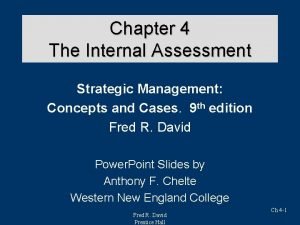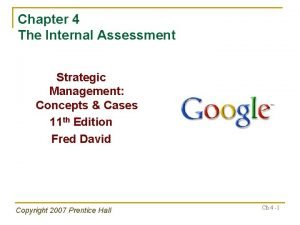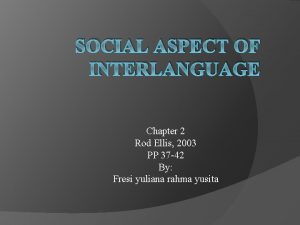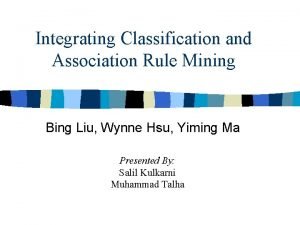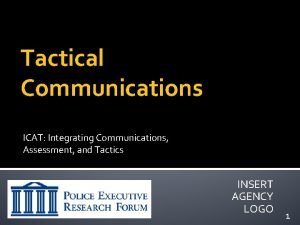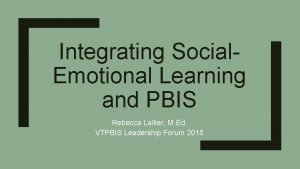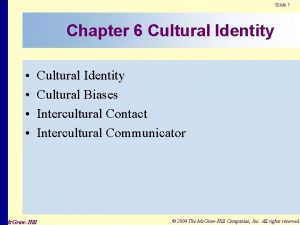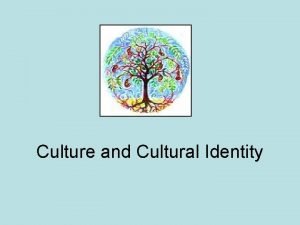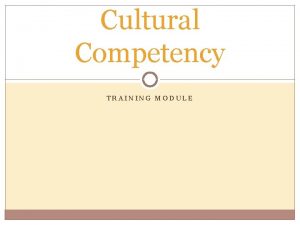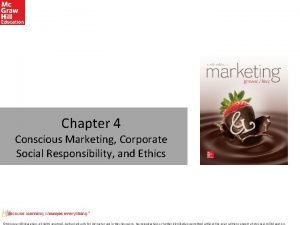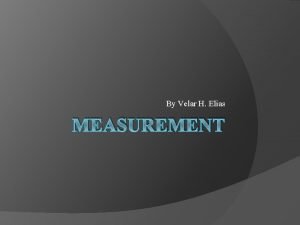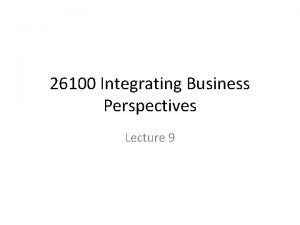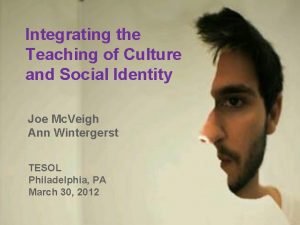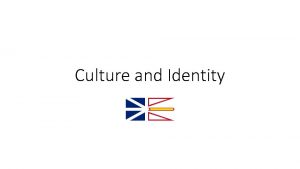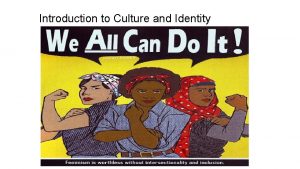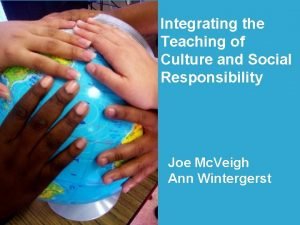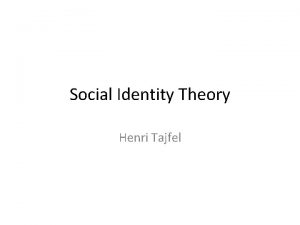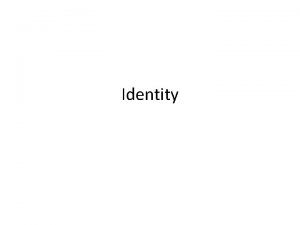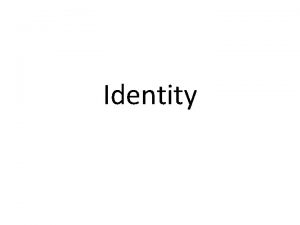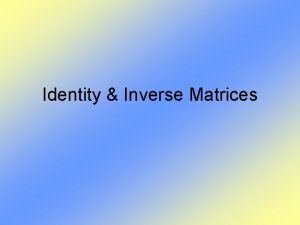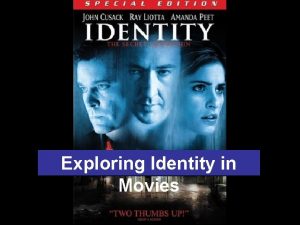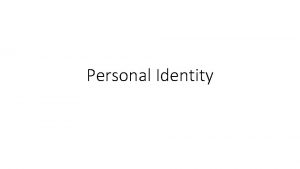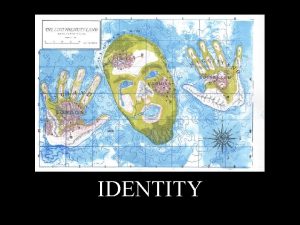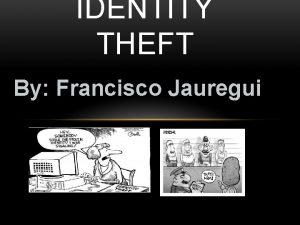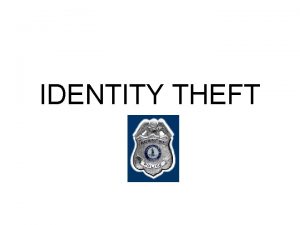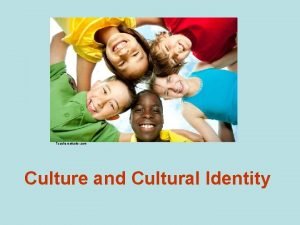Integrating the Teaching of Culture and Social Identity





















































- Slides: 53

Integrating the Teaching of Culture and Social Identity Joe Mc. Veigh Ann Wintergerst TESOL Philadelphia, PA March 30, 2012

1. Define a common vocabulary to talk about culture

Have students articulate their own definitions of culture • Definitions of culture

Have students articulate their own definition of culture • Products, practices, and perspectives • Artifacts, actions, and meanings (Moran, 2001) • A set of basic ideas, practices, and experiences that a group of people share

Have students articulate their own definition of culture • The shared beliefs, norms, and attitudes that guide a group of people’s behavior and help explain their world (De. Capua & Wintergerst, 2004) • “A complex frame of reference that consists of patterns of traditions, beliefs, values, norms, symbols, and meanings that are shared to varying degrees by interacting members of a community” (Ting-Toomey, 1999)

Have students articulate their own definition of culture (3)

Have students articulate their own definition of culture Culture = an integrated system of learned behavior patterns that are characteristic of the members of any given society. Culture refers to the total way of life of particular groups of people. It includes everything that a group of people thinks, says, does and makes— its systems of attitudes and feelings. Culture is learned and transmitted from generation to generation (Kohls, 1996)

2. Explore concepts of personal identity

What is identity? • Our sense of self • The way we see ourselves as individuals • The way we interact with others • Within our first culture and other cultures

Ways to categorize identity • Primary identities and secondary identities (Ting. Toomey, 1999) • Primary identities impact our lives ongoing • Secondary identities are changeable • Primary: personal identity, gender identity, cultural identity, and ethnic identity • Their formation and communication is interconnected with our culture

Personal identity? • Exists in each human being • Influences the ways in which we interact • Affected by our experiences, background, and personality traits • Family plays a key role in defining who we are • Sets us apart from other individuals

Age • Plays out differently in each culture • High status of the old and respect from the young in collectivistic cultures • Age has no status in individualistic cultures (Gudykunst & Kim, 2003)

Social class • We each belong to one and identify with one • How viewed depends on one’s place on the social scale • Social class structures differ from one society to another • Factors of social class identity are similar across cultures

Religion • Helps define a sense of self and a world view • Religious beliefs give a sense of place in the universe • Interacting with “sacred wisdom” (Samovar & Porter, 2004) • Gives rise to moral and ethical beliefs and behaviors

Personal identity linkage • To cultural and social identities • Threatened cultural identity is an affront to our sense of self • People stand up for their country when it’s disparaged • Language difficulties threaten personal identity

What the teacher can do • Must have a good sense of their own identity • Achieved by self-reflection, journaling, talking • Makes them good models for students • Use questionnaires, discussions, journaling, writing assignments, reading/discussion of essays, stories, biographical writings of others • Use Activity 2 for student self-exploration

Activity 2: Exploring Personal Identity 1. 2. 3. 4. 5. 6. The goal is for students to create a collage to represent their personal identities. A simple form of collage involves selecting, cutting, and pasting photographs, printed text, hand-written texts, drawings, digital images and text onto paper. Prepare a model of the type of collage that you would like to see your students produce. Show students your collage to introduce the activity. Two weeks before the start of the project, ask the class to bring in magazines and newspapers with photographs. Encourage students to bring all types of magazines so that there will be a variety of photographs and text to choose from. Decide if you want to devote class time to this activity or ask students to do their collages as homework. Instruct students accordingly. Tell students the project is to make a collage that represents their personal identity. They should include information they feel represents who they are, their interests, their views, etc. Point out that they can use photos, bits of text, their own drawings or writings – anything that helps portray how they see themselves. Have students bring their completed collages to class. Display them around the classroom. Ask students to walk around the room and enjoy the collages. Give the class an opportunity to ask any questions about their classmates’ collages

3. Explore gender identity and roles

Gender and Identity • Influence of individual • Influence of society • Women and power -- expectations

Gender and Identity • Fundamental aspects • Roles expectations can be learned and unlearned • Differences across cultures

Gender and Identity • Expectations across cultures • Expressions of sexual identity • Use of language and nonverbal communication

Activity 3: Exploring gender identity • • • Create a poster Brainstorm characteristics Collect visual images One poster each for men and women Discussion

4 Build awareness of social identity and roles

Build awareness of social identities & roles • “Show me who your friends are and I’ll tell you who you are. ” • People around us, groups we belong to, roles we have • Social identity: commonalities with others and how they see us • Social roles: the socially expected behavior patterns we hold

Social identity • Linked to our roles in life: student, teacher, parent, sibling • To our physical features: ethnicity, gender, age • To memberships we hold: organization, club, political party

Social identity • Children view themselves initially as family members • With awareness of social groups, they form social identities • Growing older, group memberships expand based on interests • In-group membership is key to our identity (Lustig & Koester, 2003)

Social Identity • Belonging to a cultural group adds to our social identity • Learning about our traditions, language, religion, social structures • Internalizing our culture’s beliefs we connect and identify with it • Groups related to work, religion, or others mold our social identity

Social Roles • Social structure includes formal rules, behaviors, social roles • The roles played contribute to our social identity • Cultural expectations of how people in a social position are to behave (De. Capua & Wintergerst, 2004) • Some social roles are given to us: gender, age, social status • Others depend on actions gained by: education, hard work, marriage

Aspects of social role identity • Differences in the level of formality • Degree of hierarchy in role relationships • Status or relative position of importance • Certain forms of address make roles explicit

What the teacher can do • Call attention to the many groups to which students belong • Point out the function of roles as part of social identity • Use Activity 4 to help students recognize what social identity is • Role play allows students to get a sense of the concept

Activity 4 • • Exploring social identity and roles Make copies of the handout. Pass them out to the class. Explain the concept of a role play. Students choose a character and role-play how this person would act in the situation. Remind students that they are taking on the character's social identity and social role. Have them think about any differences in social status of the characters, etc. Provide a model by demonstrating one of the role plays with a student in front of the class. Form pairs and assign role plays. Ask students to imagine what the character is like based on her social identity and role. They might invent the name and age of the character, where she is from, and what she looks like. Give the class time to practice. Walk around and provide feedback as needed. Have students act out their role plays in front of the class. To finish the activity, ask the class to discuss the following questions: – How did you feel about taking on the role of another person? What was easy about the role? What was difficult? – How was it different when you switched roles? • What ideas or thoughts do you have about culture and identity after role-playing your character(s)?

5. Recognize differences among cultural identities www. flickr. com/photos/varun/4294741565/

Cultural identity • Relation to social identity and personal identity • Strength varies • Positive and negative perceptions

Cultural identity • • • Sense of self Strength of identification Individualism vs. collectivism Multiple identities Social distance

Activity 5: Dimensions of cross cultural identity • Make copies of the handouts for Activity 5 • Review with students that a critical incident is a cross-cultural problematic situation. The incidents are concerned with various dimensions of culture. Inform the students that there is no right or wrong answer, but that there are solutions. • Ask students to work in groups of 3 -4. Pass out the handouts. Assign each group one critical incident. Have students read the critical incidents and questions and discuss what they think caused the conflict. • If a group finishes early, assign them another critical incident. • As a class, discuss each critical incident, the solutions from each group, and the area of cultural conflict manifested. Share possible interpretations with the class if none of the groups have already suggested them.

6. Identify cultures as either individualistic or collectivistic www. flickr. com/photos/elvire-r/2451784799/

Individualistic / Collectivistic • Cultural identity deals with the nature of the culture in which we find our identity • Individualism – primary importance is on the individual • Collectivism - the well-being of the group takes priority • Implications for how students learn • Relationship between the individual and the group at the heart of identity (Hofstede, et al. , 2002)

Individualism-collectivism index Highly Individualistic ----------- Highly Cultures Collectivistic Cultures Individuals take care of themselves and their immediate family first. The autonomy of the individual and the self are most important. Characteristics United States, Australia, Great Britain, Canada, Example Hungary, the cultures Netherlands, New Zealand, and Italy Individuals work for the good of the group and suppress their identity for the benefit of the group. The needs of the group come before the needs of the individual. Guatemala, Ecuador, Panama, Venezuela, Colombia, Pakistán, Indonesia, and Costa Rica (Hofstede et al. , 2002)

Predictors of individualismcollectivism • Economic development: – Wealthy cultures tend to be individualistic – Poor cultures tend to be collectivistic • Climate: – Cultures in colder climates tend to be individualistic – Cultures in warmer climates tend to be collectivistic

Effects on student learning • learning style preferences - (Ehrman & Oxford, 1990) • English speakers rated individual learning highest; ESL students did not (Reid, 1987) • American students studying a foreign language preferred individual work; ESL counterparts preferred group work (Wintergerst, et al. , 2002) • Russian ESL/EFL students and Asian (Chinese, Korean, and Japanese) ESL students preferred group work over individual work (Wintergerst, et al. , 2003) • Chinese learning is characterized by cooperation 1995) (Nelson,

What the teacher can do • Ask students to think about their own culture and identify their cultural characteristics • Bring in readings illustrative of individualism and collectivism, i. e. , short stories or articles • Refer advanced students to Lustig and Koester’s Intercultural competence: Interpersonal communication across cultures, pg. 125, which gives 69 country ratings on the individualism-collectivism dimension adapted from Hofstede

Activity 6: Alone or with others? 1. Present the concept of individualistic and collectivistic cultures. Draw a continuum showing the characteristics of each type culture. 2. Write the students' home countries on the board. Ask students if they think their own culture is more individualistic or collectivistic. 3. Ask students to think of examples of phrases, expressions, situations, or proverbs that illustrate either the collectivistic or individualistic nature of their culture. Write examples on the board: The nail that stands up will be hammered down. The squeaky wheel gets the grease. All for one and one for all. 4. To finish the activity, have volunteers share their ideas with the class.

Examples • Strongly Individualistic United States • Somewhat Individualistic Switzerland • Neutral Japan, Russia • Somewhat Collectivistic China • Strongly Collectivistic Guatemala

Individualistic or collectivistic? Guess where these countries fall on the chart: Two are neutral Two are strongly collectivistic Two are strongly individualistic Indonesia, Netherlands, New Zealand, Pakistan, Spain, Turkey

Answers Strongly Individualistic: New Zealand, Netherlands Neutral Spain, Turkey Strongly Collectivistic Indonesia, Pakistan

7. Show ethnic identity influences social identity

Ethnic identity • Categorization based on ethnicity • Cultural, social, psychological, physical • Members vs. non-members

U. S. historical perspective • Assimilation: melting pot • Pluralism: salad bowl / mosaic

Ethnicity and language • Emotional connection = solidarity • Level of identification • Strength of identity and content may differ

Activity 7 – Ethnic identity in film • Make copies of the handout. Pass them out to the class. • Choose a film that highlights ethnic roles within a culture. Some suggestions are: My Big Fat Greek Wedding (2002), Guess Who’s Coming to Dinner (1967), Bend it Like Beckham (2003), Pleasantville (1998), and Witness (1985). • Discuss the questions with the class before watching the movie. • During the movie, stop as often as necessary to explain any key plot or language points that may be difficult for students. • Form pairs. Have students answer the questions. • To finish the activity, discuss the answers with the class.

Questions www. flickr. com/photos/eleaf/2536358399/

Check out our book at the Pearson booth or online !

Download copies of the handout and Power. Point slides at www. joemcveigh. org/presentations Thank you ! www. flickr. com/photos/tacitrequiem/2970523639/
 A firm's strengths that cannot be easily matched
A firm's strengths that cannot be easily matched Internal assessment in strategic management ppt
Internal assessment in strategic management ppt Integrating science and social studies
Integrating science and social studies Identity mapping activity
Identity mapping activity Difference between traditional teaching and micro teaching
Difference between traditional teaching and micro teaching Stylistic continuum
Stylistic continuum Interlanguage and social identity and investment
Interlanguage and social identity and investment Non material culture
Non material culture Fed-batch
Fed-batch American vs indian culture
American vs indian culture Stroke culture method
Stroke culture method Folk culture and popular culture venn diagram
Folk culture and popular culture venn diagram Examples of mass culture
Examples of mass culture Tsi
Tsi Folk culture and popular culture venn diagram
Folk culture and popular culture venn diagram Lawn culture method
Lawn culture method Robertson cooked meat medium
Robertson cooked meat medium Surface culture deep culture and esol
Surface culture deep culture and esol Integrating classification and association rule mining
Integrating classification and association rule mining Integrating factor exact equations
Integrating factor exact equations Integrating qualitative and quantitative methods
Integrating qualitative and quantitative methods Tactical communication skills
Tactical communication skills Integrating sel and pbis
Integrating sel and pbis Integrating public health and primary care
Integrating public health and primary care Why is culture identity important
Why is culture identity important Why is culture identity important
Why is culture identity important Cultural competency training modules
Cultural competency training modules Social thinking adalah
Social thinking adalah Social thinking social influence social relations
Social thinking social influence social relations Sociologists define a symbol as
Sociologists define a symbol as Batch culture vs continuous culture
Batch culture vs continuous culture Collectivistic cultures
Collectivistic cultures Sub culture group
Sub culture group Adaptive culture from inert culture
Adaptive culture from inert culture Quality culture changing hearts minds and attitudes
Quality culture changing hearts minds and attitudes Quotation acceptance form
Quotation acceptance form Embedded quotes mla examples
Embedded quotes mla examples Axon
Axon Differential equation exponential solution
Differential equation exponential solution Bluestar plm
Bluestar plm Basic concepts on integrating technology in instruction
Basic concepts on integrating technology in instruction Integrating factor of linear differential equation
Integrating factor of linear differential equation Integrating marketing communication to build brand equity
Integrating marketing communication to build brand equity Conscious marketing definition
Conscious marketing definition Integrating type dvm
Integrating type dvm Integration by parts meaning
Integration by parts meaning Bonding relationship stage
Bonding relationship stage Integrating factor
Integrating factor Dialogue quote vs flow quote
Dialogue quote vs flow quote Separation of variables
Separation of variables What is a first order equation
What is a first order equation The intent of project metrics is:
The intent of project metrics is: Integrating quotations exercise
Integrating quotations exercise Integrating business perspectives
Integrating business perspectives
